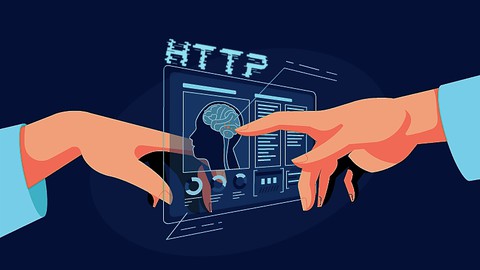
Getting started with HTTP
Getting started with HTTP, available at $54.99, has an average rating of 4.5, with 21 lectures, 2 quizzes, based on 264 reviews, and has 804 subscribers.
You will learn about What happens when you enter a website What is the HTTP Protocol and how it works URL, URL Structure and URL Encoding HTTP Request Methods Safe vs. Unsafe HTTP Methods Idempotency HTTP Status Codes WebSockets HTTP Sessions What is Caching What are Cookies The HTTP Workflow What are the improvements of HTTPs Hands-on experience with Wireshark and Fiddler This course is ideal for individuals who are Programmers, IT Students and curious audience about how the internet works. It is particularly useful for Programmers, IT Students and curious audience about how the internet works.
Enroll now: Getting started with HTTP
Summary
Title: Getting started with HTTP
Price: $54.99
Average Rating: 4.5
Number of Lectures: 21
Number of Quizzes: 2
Number of Published Lectures: 21
Number of Published Quizzes: 2
Number of Curriculum Items: 23
Number of Published Curriculum Objects: 23
Original Price: $94.99
Quality Status: approved
Status: Live
What You Will Learn
- What happens when you enter a website
- What is the HTTP Protocol and how it works
- URL, URL Structure and URL Encoding
- HTTP Request Methods
- Safe vs. Unsafe HTTP Methods
- Idempotency
- HTTP Status Codes
- WebSockets
- HTTP Sessions
- What is Caching
- What are Cookies
- The HTTP Workflow
- What are the improvements of HTTPs
- Hands-on experience with Wireshark and Fiddler
Who Should Attend
- Programmers, IT Students and curious audience about how the internet works.
Target Audiences
- Programmers, IT Students and curious audience about how the internet works.
Hypertext Transfer Protocol (HTTP)is the protocol programs use to communicate over the World Wide Web. HTTP is most famous for two-way conversation between clients (the web browsers) and web servers.
In this tutorial, we are going to dive in depth into all the aspects of the HTTP protocol in order for us to understand exactly how it works, what are its key components and also its entire workflow.
We will learn how to use tools such as Fiddlerand Wiresharkamong others.
We will understand all the status codes that an HTTP Request might return and all the HTTP Request Methods.
You will also understand the structure of a URL, how you can encode information on it and what is its role in this protocol.
Lastly, we will see the differences between HTTP and HTTPs, and see what improvement the second one brings.
I will be adding more lectures / supplementary materials on the course as it goes by.
This tutorial is for anyone who wants to understand HTTP and the underlying architecture of the Web.
No programming experience is required, but technical writers with programming experience who want to know more about the HTTP Protocol will still find it useful.
Thanks for reading my introduction! This is about YOUR time and making the most of it! Good luck to you and hope to see you in the course! Alex!
Course Curriculum
Chapter 1: Introduction
Lecture 1: Welcome to this course!
Chapter 2: The HTTP Protocol
Lecture 1: HTTP Responses (Status codes)
Lecture 2: HTTP Request Methods
Lecture 3: What is HTTP and how it works
Lecture 4: HTTP Key Components
Lecture 5: HTTP Workflow
Lecture 6: Caching in HTTP
Lecture 7: Cross Origin Resource Sharing
Lecture 8: Debugging HTTP Requests
Chapter 3: URLs
Lecture 1: What is an URL
Lecture 2: The structure of an URL
Lecture 3: The URL Encoding Process
Chapter 4: Deep Dive into HTTP and HTTPS notions
Lecture 1: HTTP Sessions and Cookies
Lecture 2: WebSockets and Real-Time Communication in HTTP
Lecture 3: The improved HTTPS protocol
Lecture 4: What is an IP Address?
Chapter 5: Hands-on approach on real-life applications
Lecture 1: Fiddler
Lecture 2: WireShark
Lecture 3: How to Create a HTTP Request using code?
Chapter 6: Where to go from here?
Lecture 1: Bonus lecture (FREE GIFT)
Chapter 7: HTTP Quiz
Lecture 1: Wecome to the quiz of this course!
Instructors
-
Programming Made Easy
Software Engineer, Computer Science BSc
Rating Distribution
- 1 stars: 11 votes
- 2 stars: 9 votes
- 3 stars: 32 votes
- 4 stars: 49 votes
- 5 stars: 163 votes
Frequently Asked Questions
How long do I have access to the course materials?
You can view and review the lecture materials indefinitely, like an on-demand channel.
Can I take my courses with me wherever I go?
Definitely! If you have an internet connection, courses on Udemy are available on any device at any time. If you don’t have an internet connection, some instructors also let their students download course lectures. That’s up to the instructor though, so make sure you get on their good side!
You may also like
- Best Yoga Instruction Courses to Learn in March 2025
- Best Stress Management Courses to Learn in March 2025
- Best Mindfulness Meditation Courses to Learn in March 2025
- Best Life Coaching Courses to Learn in March 2025
- Best Career Development Courses to Learn in March 2025
- Best Relationship Building Courses to Learn in March 2025
- Best Parenting Skills Courses to Learn in March 2025
- Best Home Improvement Courses to Learn in March 2025
- Best Gardening Courses to Learn in March 2025
- Best Sewing And Knitting Courses to Learn in March 2025
- Best Interior Design Courses to Learn in March 2025
- Best Writing Courses Courses to Learn in March 2025
- Best Storytelling Courses to Learn in March 2025
- Best Creativity Workshops Courses to Learn in March 2025
- Best Resilience Training Courses to Learn in March 2025
- Best Emotional Intelligence Courses to Learn in March 2025
- Best Time Management Courses to Learn in March 2025
- Best Remote Work Strategies Courses to Learn in March 2025
- Best Freelancing Courses to Learn in March 2025
- Best E-commerce Strategies Courses to Learn in March 2025






















